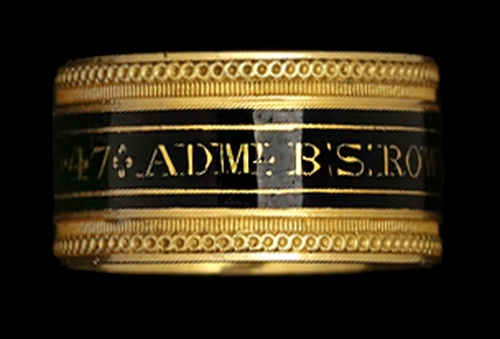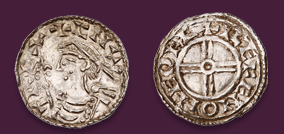Auction: 25003 - Orders, Decorations and Medals
Lot: 87
(x) A delicate and most attractive Georgian Mourning Ring, struck in memory of Admiral B. S. Rowley
Mourning Ring, gold and enamel, inscribed around the outer edge in gold letters on a black enamel field: 'Adml. B: S: Rowley. Died 7. Oct: 1811. Aged. 47', maker's mark 'T.M.', hallmarks for London 1811, good very fine and rare
Bartholomew Samuel Rowley was born on the 10 June 1764 to a prominent British naval family: he was the fifth child of Vice-Admiral Sir Joshua Rowley and his wife, Sarah Burton. His extended family included his grandfather, Admiral of the Fleet Sir William Rowley, his uncle Major-General William Rowley, and his brother-in-law, Admiral Sir Charles Cotton. He was also the older brother of Admiral Sir Charles Rowley and uncle to Rear-Admiral Sir Joshua Ricketts Rowley.
In 1775 Rowley enrolled at Harrow School, likely only staying until 1777-78 before he joined the Royal Navy and commissioned as Lieutenant. By 1780, Rowley was aboard his father's flagship, H.M.S. Conqueror, but was promoted Commander on 1 November that year and placed in command of the sloop Tobago until 31 January 1781. Remarkably, at just 16 years old Rowley was made Post-Captain in order to command H.M.S. Resource. Such a position so young was extremely unusual and undoubtedly a result of his esteemed naval familial background. Rowley's career as Captain spanned 1781 to 1799, thus encountering the French and Haitian Revolutions and the Napoleonic Wars; it was whilst in command of Resource that Rowley saw his first true taste of action - the renowned naval author and historian William Laird Clowes described the encounter thus:
"The British 28-gun frigate Resource, Captain Bartholomew Samuel Rowley, was cruising in the West Indies, when, on April 20th, she sighted a large sail. As the stranger bore down upon her, she cleared for action and engaged at about 4.30 in the afternoon. The enemy struck at six; she proved to be the Licorne, a French frigate, commanded by Captain de St. Ture, and mounting twenty 9-prs. and eight 12-pr. carronades. The Resource had her Gunner killed and her second Lieutenant wounded. Her loss in killed and wounded was much heavier than that of the French ship. The gallantry of his crew was greatly commended by Captain Rowley, as was that of some soldiers of the Loyal American Rangers who were on board. The Licorne had passed through many vicissitudes, as she had been originally a British vessel, but had been taken by the French in September 1780, as has been shown." (The Royal Navy: A History from the Earliest Times to the Present, W. Laird Clowes, p. 63, refers).
Rowley's next appointment was to H.M.S. Diamond, a fifth-rate 32-gun frigate where he served as Captain between 5 October 1782 to 24 August 1783, notably during the last stages of the American War of Independence. While records pertaining to Rowley's captaincy of this ship are sparce, but we do know that he was serving under his father who had become Commander-in-Chief of the Jamaican station. After the American War of Independence, Rowley was placed on half-pay while not on active duty, as was common practice. It was not for ten years until Rowley commanded another ship.
The outbreak of the French Revolutionary War in 1793 put Rowley back at sea commanding the H.M.S. Penelope and serving in the Jamaica Station. Taking advantage of the unstable political situation in the French colony Saint-Domingue (now Haiti), the Penelope sailed from Môle-Saint-Nicolas to intercept the French 32-gun frigate L'Inconstante which was escorting a large merchant ship. Proceeding to the harbour of Port-au-Prince, on the night of the 25 November 1793, the attack between Penelope and L'Inconstante began. In Rowley's own words he penned in the London Gazette:
"I immediately made Sail, with Intention of trying to take or destroy her in the Harbour; but on the Night of the 25th we had the good Fortune to fall in with her, and after exchanging a few Broadsides, the struck her Colours to the Frigates" (London Gazette 8 February 1794 p.129 refers).
The Penelope had only one man killed and seven wounded while L'Inconstante had nine killed, including the Captain and First Lieutenant with 17 wounded. The L'Inconstante eventually surrendered. Around six weeks later, Commodore John Ford sent Penelope into Port-au-Prince under a truce flag where Rowley demanded the surrender of the island from Léger-Félicité Sonthonax, the Governor of Saint-Domingue. Sonthonax refused and consequently the British blockaded the island. Commodore Ford penned in the London Gazette:
"I proceeded off Port-au-Prince in order to induce a Capitulation to the King my Master; and accordingly sent Captain Rowley of the Penelope, on the 2d Instant, with a Flag of Truce, to the Civil Commissary Santhonax, offering the same Capitulation which the Inhabitants of St. Marc had voluntarily accepted, but which he refused in toto. As I found that Intreaty had no Effect, I determined to establish a Blockade, which has continued ever since, and not a Vessel of any Description entered." (London Gazette 11 March 1794 p. 227 refers).
On the 4 June 1794 Port-au-Prince finally surrendered and Rowley was sent back to England with dispatches aboard the sloop Fly. Upon his return, Rowley was appointed Captain of the H.M.S. Cumberland and took part in the Battle of the Hyères Islands on 13 July 1795. Cumberland was a leading ship in this battle, along with H.M.S. Culloden and H.M.S. Victory. The wind favoured the British, allowing them to make great advances on the French. At the back of the French fleet was Alcide which eventually surrendered to Cumberland. Yet Rowley did not accept this surrender and advanced to attack the next French ship in the line. There were few British losses, with 11 killed and 28 wound across the five ships. Cumberland suffered no casualties even though it was the most heavily engaged of the British fleet.
Rowley's final captaincy was of H.M.S. Ramillies between July 1797 and October 1798. After his captaincy he was promoted to the rank of Rear-Admiral of the Blue which he served from the 14 February 1799 to the 1 January 1799. He then became Rear-Admiral of the White on 1 January 1801 and Rear-Admiral of the Red in 1804. Rowley was then promoted to Vice-Admiral of the White and was Flag Officer of H.M.S. Veteran in 1808 and H.M.S. Polyphemus in May 1808.
Rowley's last appointment was Commander-in-Chief, Jamaica station between 1809-1811, holding the position like his father had previously in 1782. He also assumed the positions of Vice-Admiral of the Red in 1809 and Admiral of the Blue in 1810. While stationed out in Jamaica, Rowley died suddenly on the 7 October 1811 at the age of 47. He had fallen ill two weeks prior with a fever, likely yellow fever, which was often deadly to Europeans in the West Indies at that time. He was interred at Kingston Parish Church Cemetery the following afternoon interred with full military procession. A memorial plaque, erected by his widow Arabella, is in Suffolk, in the Church of St Mary the Virgin, Stoke-by-Nayland.
Subject to 5% tax on Hammer Price in addition to 20% VAT on Buyer’s Premium.
Estimate
£1,000 to £1,500
Starting price
£800







